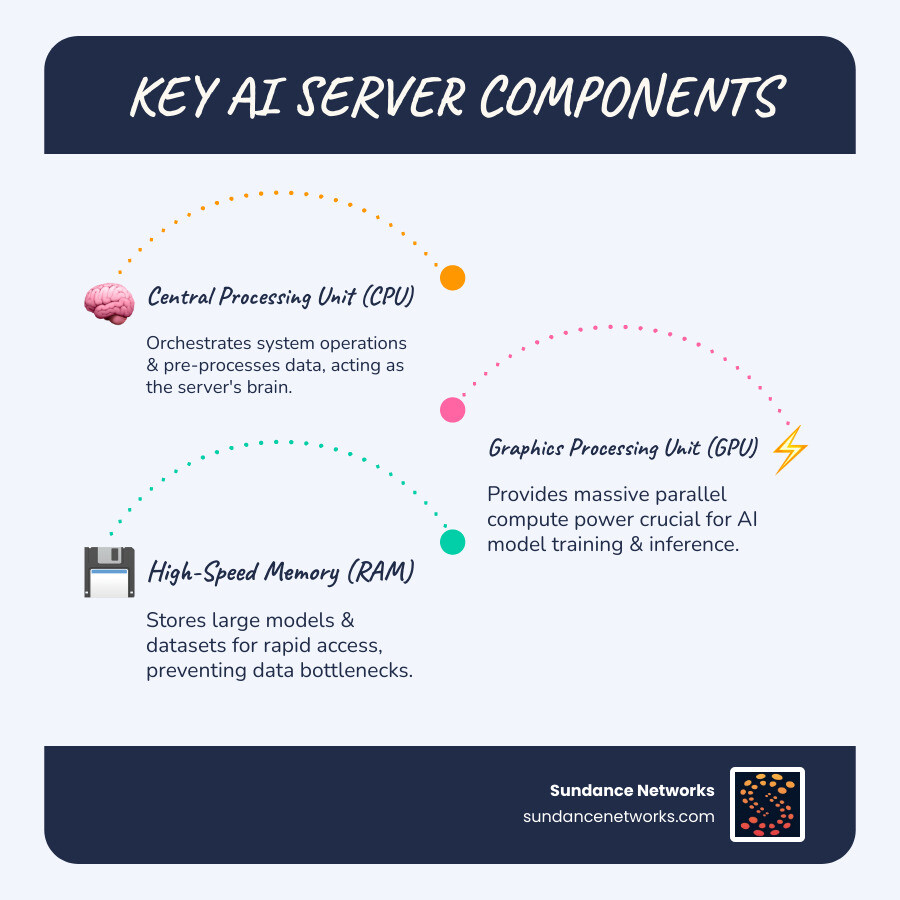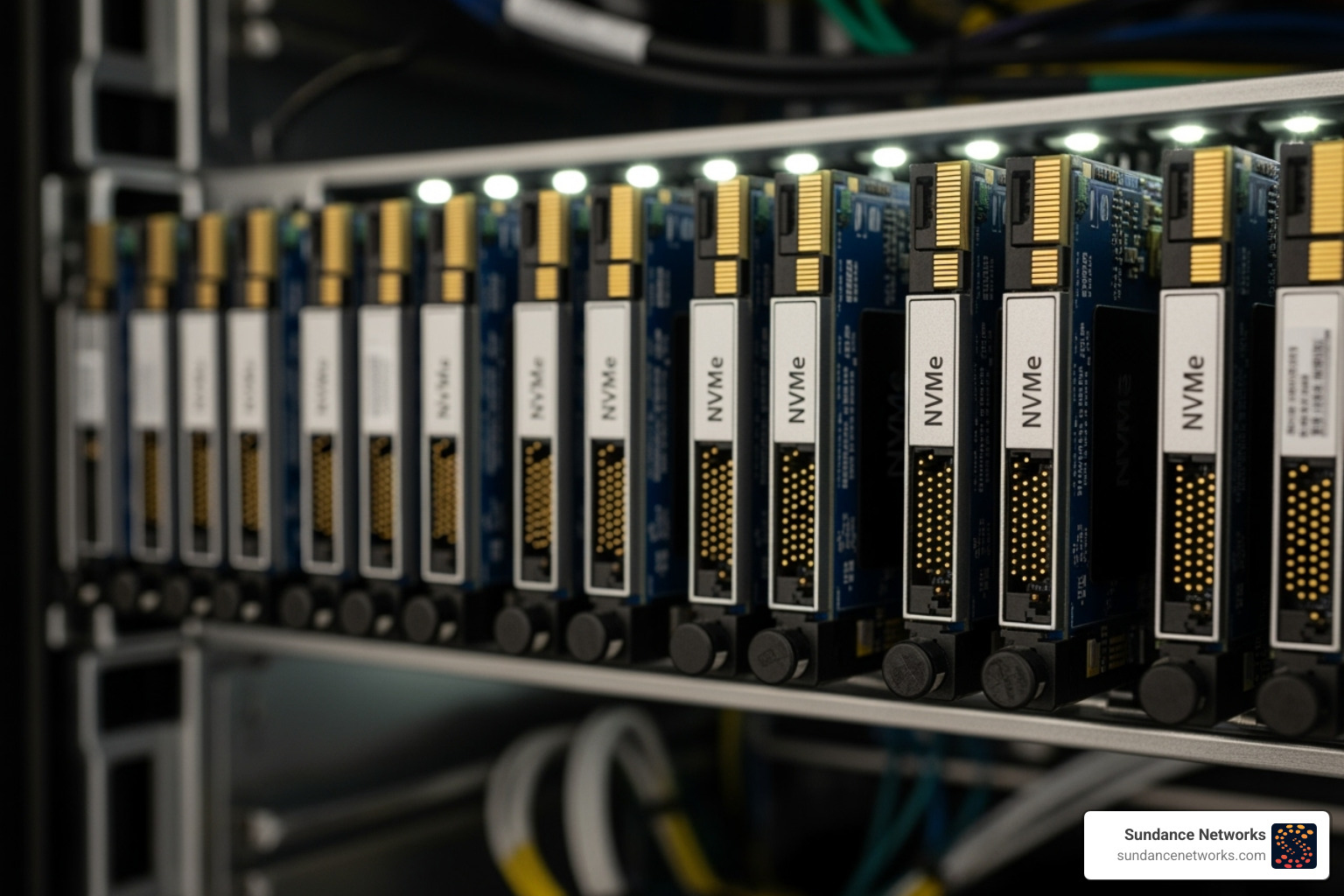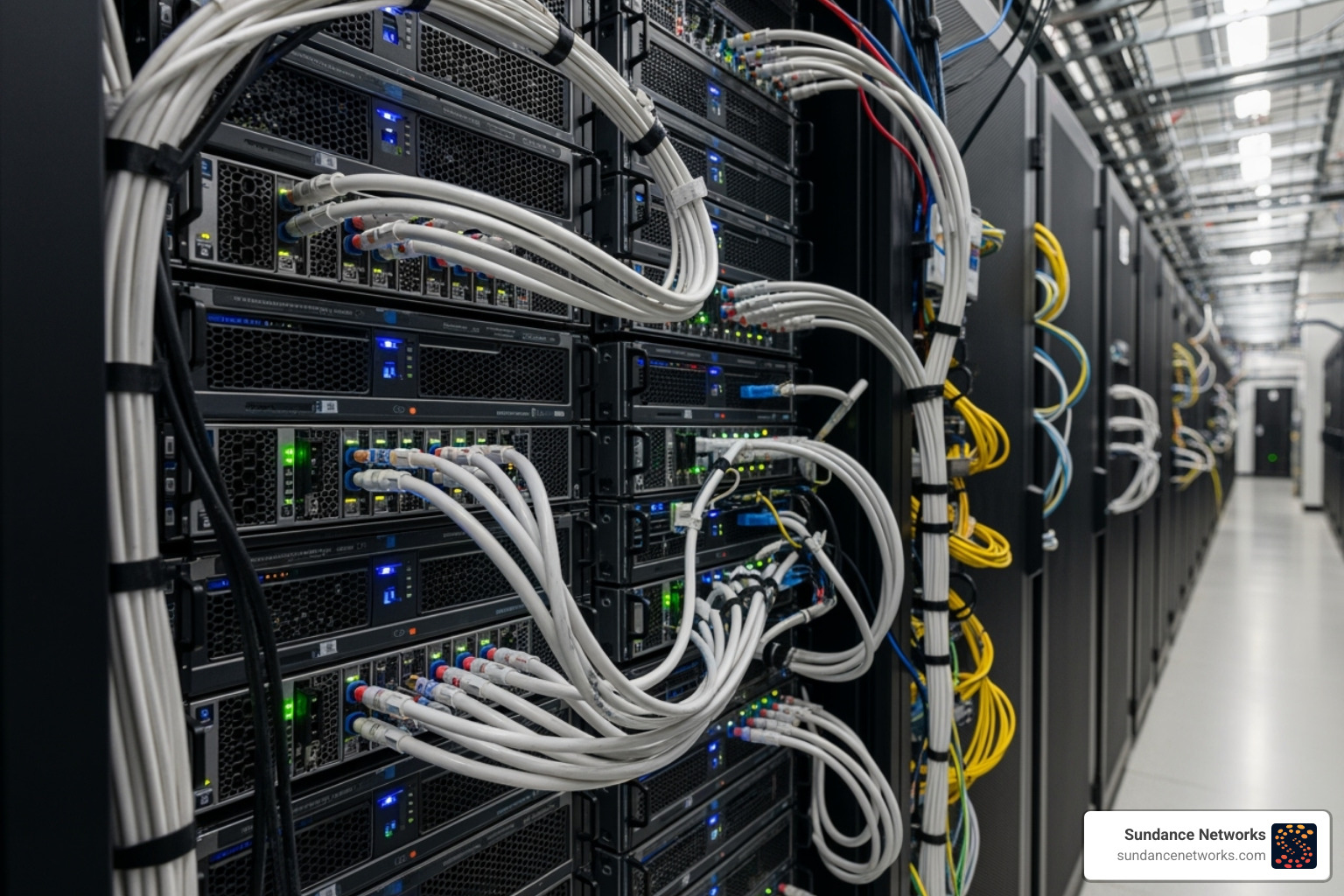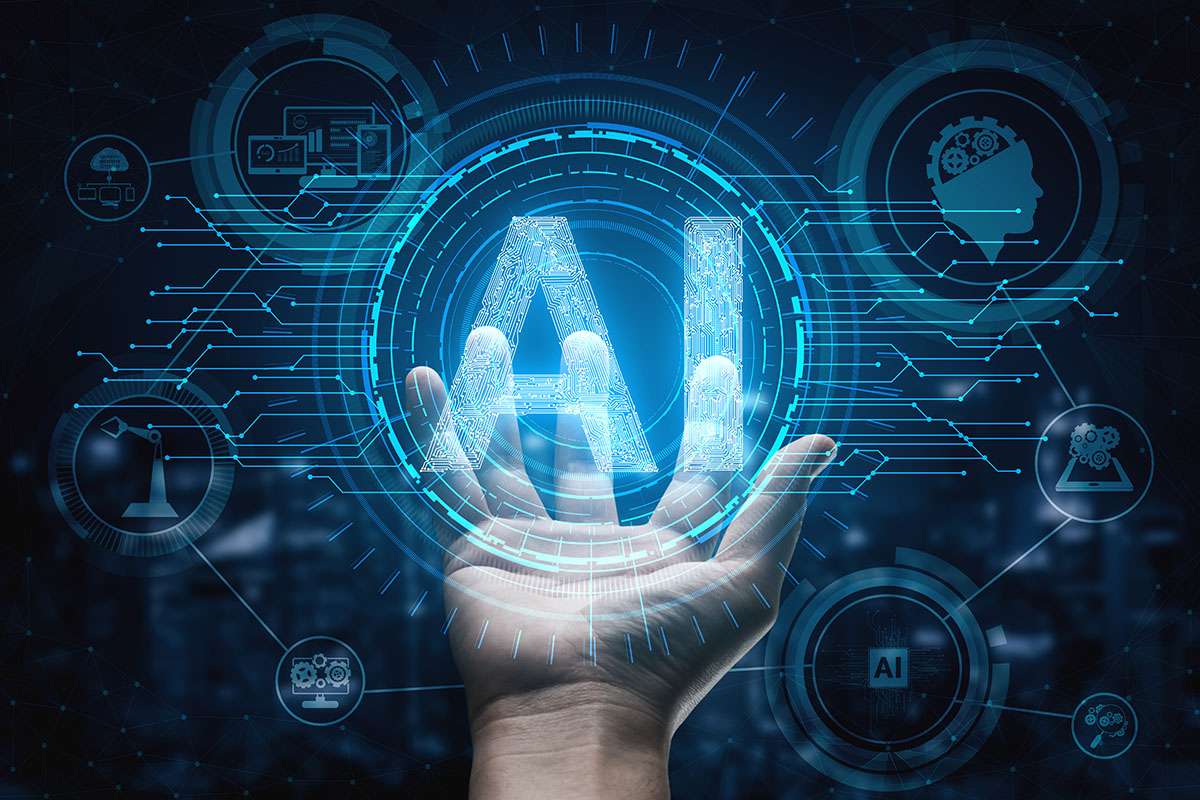Why AI Server Hardware is the Foundation of Modern Business
AI server hardware refers to specialized computer systems designed to handle the massive computational demands of artificial intelligence workloads, from training complex models to running real-time inference applications.
Key Components of AI Server Hardware:
- CPUs (Central Processing Units): Handle data preprocessing and system management
- GPUs (Graphics Processing Units): Provide parallel processing power for AI training and inference
- High-Speed Memory (RAM): Stores data and models during processing (typically 64GB to 6TB+)
- Fast Storage (NVMe SSDs): Prevents data bottlenecks with rapid read/write speeds
- Networking: Enables high-speed data transfer and cluster communication
- Cooling Systems: Manage heat from power-hungry components
- Power Supplies: Deliver reliable electricity to demanding hardware
The numbers tell the story of AI’s explosive growth. OpenAI research shows compute requirements for large deep learning projects doubled every 3.4 months between 2012 and 2017—a 300,000-fold increase. Today, AI servers are ubiquitous in every industry, powering everything from edge devices to cloud-based generative AI.
Unlike general-purpose servers, AI servers are architected with specialized components for massive parallel processing, high-speed data access, and efficient thermal management. The right hardware is critical for gaining a competitive advantage and avoiding performance bottlenecks.
I’m Ryan Miller, founder of Sundance Networks with over 17 years in IT and 10+ years specializing in information security, including deploying and managing AI server hardware for businesses across various industries.

Anatomy of an AI Server: The Core Components
This section details the essential parts of an AI server, explaining how they work together to handle demanding AI tasks.
The Central Brain: Central Processing Units (CPU)
While GPUs get the spotlight, the Central Processing Unit (CPU) is the server’s brain. In an AI server hardware setup, the CPU manages the OS, coordinates tasks, handles data pre-processing, and runs non-GPU computations.
When selecting a CPU, we consider its core count and clock speed. The CPU needs enough power to feed data to the GPUs efficiently and manage the system. We recommend at least 4 CPU cores per GPU, with 32 or 64 cores for more demanding workflows. High-performance server-grade CPUs, such as AMD EPYC or Intel Xeon processors, are often go-to choices for their reliability, large core counts, and ample PCI-Express lanes, which are crucial for connecting multiple GPUs and supporting large amounts of memory.
For more information on how we approach server selection and optimization, you can explore our comprehensive hardware solutions.
The Powerhouse Accelerators: GPUs, TPUs, and FPGAs
Accelerators are the muscle of AI, and GPUs reign supreme. Graphics processing units (GPUs) are designed for parallel processing, making them highly efficient for the massive, simultaneous calculations needed to train deep neural networks.
By 2019, GPUs had become the standard for training large-scale commercial cloud AI. NVIDIA, a leading GPU manufacturer, has become an AI superpower due to its pioneering work in this area, as detailed in this BBC News article: “Nvidia: The chip maker that became an AI superpower”.
Modern AI-focused GPUs feature specialized “Tensor Cores” optimized for the matrix multiplication fundamental to deep learning. This allows for significant performance gains, especially with mixed-precision computing (e.g., FP16).
Beyond GPUs, other specialized accelerators include:
- TPUs (Tensor Processing Units): Developed by Google, these are custom-built circuits (ASICs) that accelerate machine learning workloads, particularly for Google’s TensorFlow framework.
- FPGAs (Field-Programmable Gate Arrays): These are integrated circuits that can be configured after manufacturing, making them adaptable for custom logic and real-time processing in applications like edge AI.
While GPUs are the most versatile choice, understanding TPUs and FPGAs allows us to optimize performance for specific needs. We’re always exploring the best ways to leverage these technologies for AI Performance Optimization.
High-Speed Memory: RAM Requirements
RAM (Random Access Memory) is critical in an AI server hardware setup. It holds active AI models, training data, and intermediate computations. Ample, fast RAM is essential to prevent bottlenecks and ensure smooth data flow to the GPUs.
A common rule of thumb is to have at least double the amount of system RAM as there is total GPU memory (VRAM). For instance, a server with 64GB of total VRAM should have at least 128GB of system RAM. While 8GB of memory per GPU is minimal, 12GB to 32GB is common on high-end cards. For production models, 128GB or more is often required, with some advanced servers supporting over 6TB of memory.
We also prioritize ECC (Error-Correcting Code) memory, which detects and corrects internal data corruption, crucial for stability during long training runs. The adoption of faster DDR5 technology further improves data throughput for AI workloads.
Lightning-Fast Storage: Speed and Capacity
For AI server hardware, fast storage is crucial to prevent data streaming from becoming a bottleneck, especially when datasets are too large to fit in system memory.

We highly recommend NVMe (Non-Volatile Memory Express) SSDs for their superior read/write speeds and IOPS (Input/Output Operations Per Second) compared to SATA SSDs. A 1TB NVMe SSD is ideal for storing the OS, datasets, and models. For better performance, we often advise using separate drives for the OS and AI data.
While NVMe handles speed, capacity is also vital. For very large datasets, larger SATA SSDs can serve as a secondary tier, with traditional hard drives for archival. For massive data needs, RAID arrays can offer storage in the tens to hundreds of terabytes.
Ensuring your data is stored securely and efficiently is part of our comprehensive Data Protection Strategies.
The Data Superhighway: Networking Capabilities
In AI server hardware, networking is a high-speed data superhighway, not just an internet connection. It profoundly impacts performance, especially for distributed training where models and data are spread across multiple GPUs or servers.
High-speed interconnects like NVIDIA’s NVLink allow direct, high-bandwidth communication between GPUs, bypassing the CPU for certain operations. This is beneficial for models with a ‘history’ component, such as RNNs, LSTMs, and Transformer models.
For communication between servers, we look to high-performance solutions. While 10Gb Ethernet (10GbE) is a good baseline, solutions like InfiniBand provide much higher bandwidth (e.g., 100 Gbps) and extremely low latency. This is essential for large-scale distributed training, where minimizing communication overhead can significantly reduce training times.
Moving data quickly and reliably is fundamental to scaling AI operations. We help businesses optimize their network infrastructure, from network router configuration to high-speed data center interconnects.
Matching Hardware to AI Workloads
Different AI tasks have unique demands. This section explains how to tailor hardware choices to specific workloads for optimal performance and ROI.
Hardware for AI Training
AI training is the most computationally intensive phase of the AI lifecycle. It involves feeding vast datasets to a model through countless iterations, a process that demands immense parallel processing power. The right hardware is critical.
GPUs dominate the training landscape because they offer dramatic performance improvements over CPUs. Multi-GPU setups, interconnected with technologies like NVLink, allow for parallel computation that can reduce training time from weeks to hours.
High VRAM requirements are non-negotiable. The AI model and its data must fit into the GPU’s memory. While 8GB of VRAM is for basic experiments, 12GB to 32GB is common for production training. Massive models, like a 70 billion parameter LLM, can require 48GB, 80GB, or even 96GB+ of VRAM just to load.
High-speed networking like InfiniBand is crucial for distributed training across multiple servers, ensuring expensive GPUs don’t sit idle waiting for data.
Navigating these requirements is why we created our AI Solutions: A Practical Guide for Businesses That Want to Work Smarter, Not Harder.
Hardware for AI Inference
The inference phase is where a trained model makes predictions on new data. Unlike training, which requires raw power, inference prioritizes speed and efficiency.
Inference hardware is flexible. It can run on smaller GPUs, specialized accelerators, or even CPUs with integrated AI acceleration. The choice depends on throughput (predictions per second) and latency (time per prediction).
Efficiency is king during inference. The goal is consistent, reliable performance that handles real-world workloads without excessive power consumption.
Edge computing is a key part of many inference scenarios. Deploying AI server hardware closer to where data is generated—like smart cameras or factory sensors—reduces latency and bandwidth needs. This is crucial for real-time applications like computer vision or local speech recognition.
Hardware for Generative AI and LLMs
Generative AI and Large Language Models (LLMs) have extraordinary hardware demands that blur the lines between training and inference.
| Feature | AI Training Hardware | AI Inference Hardware |
|---|---|---|
| Primary Goal | Maximize throughput, minimize training time | Minimize latency, maximize efficiency |
| GPU Focus | High VRAM, high compute, multi-GPU, NVLink | Lower VRAM (often), high efficiency, specialized accelerators |
| CPU Role | Data feeding, system management | Model execution, pre/post-processing, integrated AI accel. |
| Memory | Very large system RAM (2x VRAM), ECC | Sufficient for model, often less than training |
| Storage | Very fast NVMe for datasets, large capacity | Fast access for model loading, less capacity for data |
| Networking | High-bandwidth (InfiniBand), low latency | Often less critical, but important for distributed inference |
| Power | Very high consumption | Optimized for efficiency, lower consumption |
| Typical Environment | Data centers, cloud | Data centers, edge devices, consumer devices |
Generative AI and LLMs are challenging due to their massive memory and VRAM needs for both training and basic operation. A 70 billion parameter model needs 64GB of VRAM just to run. This makes high-bandwidth interconnects like NVLink critical for running large models across multiple GPUs, even during inference.
The sheer size of these models pushes current AI server hardware to its limits, requiring enterprise-grade infrastructure. Our Custom IT Consulting and System Integration services can help you steer these complexities and build a system that delivers results.
Key Design and Deployment Considerations for AI Server Hardware
Beyond core components, factors like power, cooling, and management are crucial for a successful and sustainable AI infrastructure.
Power Consumption, Footprint, and TCO
AI server hardware has significant power demands. A single server with 8 high-end GPUs can consume over 2,500 watts at full capacity. This requires robust power supply units (PSUs). We recommend 80 PLUS Titanium certified PSUs for their energy efficiency (over 94%). For critical workloads, redundant power configurations (like 3+1 setups) prevent failures during long training runs.
The physical footprint is also important. AI servers pack immense power into compact 2U, 4U, or 8U rackmount configurations. This density saves data center space but creates challenges in heat and airflow management.
Smart businesses look beyond the initial price to the Total Cost of Ownership (TCO), which includes electricity, cooling, rack space, and maintenance. Right-sizing your AI server hardware helps control these expenses, as a more efficient configuration can deliver better long-term value. This strategic approach is part of effective IT Budget Planning.
Advanced Cooling Solutions: Air vs. Liquid
Effective thermal management is crucial for AI servers. Poor cooling leads to performance throttling, reduced component lifespan, and system instability. While traditional air cooling works for moderate workloads, it has limitations with high-TDP (Thermal Design Power) GPUs.

Direct Liquid Cooling (DLC) is a superior solution for high-density deployments. Coolant flows directly over hot components, dissipating heat far more effectively than air. The benefits are significant:
- Quieter Operation: Liquid-cooled systems can be up to 3 times quieter than air-cooled ones.
- Improved Longevity: Lower, more consistent operating temperatures reduce thermal stress on expensive components.
- Higher Density: Better cooling allows you to pack more powerful hardware into the same rack space, maximizing your investment.
While DLC has a higher upfront cost, the operational benefits often justify it for serious AI deployments.
Server Management and Security
Proper management and security are as important as the hardware itself. Remote management capabilities are essential for AI infrastructure that spans multiple locations or operates 24/7.
Intelligent Platform Management Interface (IPMI) and Baseboard Management Controller (BMC) technologies provide out-of-band access, allowing you to monitor, troubleshoot, and restart servers remotely, even if the OS has crashed.
Real-time monitoring with tools like Prometheus and Grafana provides visibility into system performance and thermals, helping identify issues before they cause failures. Containerization technologies like Docker and Kubernetes simplify deployment, resource sharing, and scaling by packaging AI models and their dependencies into portable environments.
Security is paramount. Your AI models and training data are valuable intellectual property. A strong security posture includes access controls, network segmentation, data encryption, and regular backups.
According to Sundance Networks, a comprehensive security approach protects both your AI assets and the underlying infrastructure. Our Managed Services and Security offerings help organizations build robust protection around their AI investments.
Choosing Your Arena: Data Center, Edge, and PC
The ideal AI hardware configuration depends heavily on where the computation happens.
Data Center AI Servers vs. General-Purpose Servers
Running serious AI workloads on general-purpose servers is inefficient and not built for the task. Purpose-built AI server hardware is necessary for optimal results.
Data center AI servers are engineered for the specific demands of machine learning, offering:
- Optimized Performance: Motherboards support multiple high-end GPUs with specialized interconnects.
- Scalability: Designed to easily add more GPUs, memory, or storage as your needs grow.
- Higher GPU Density: AI servers can house 8-10 GPUs in a compact 4U or 5U form factor, far more than a general-purpose server.
- Specialized Interconnects: Technologies like NVLink and InfiniBand provide ultra-fast communication pathways essential for distributed training.
These purpose-built systems also include optimized power delivery and advanced cooling to handle sustained heavy loads, often with pre-installed software to streamline deployment.
Unique Requirements for Edge AI Hardware
Edge AI brings intelligence directly to where data is generated, rather than sending it to a central data center. This requires specialized AI server hardware with unique characteristics.

Key requirements include:
- Low Power Consumption: Many edge devices operate on tight power budgets, requiring efficient AI chips like NPUs or FPGAs.
- Small Footprint: Compact design is mandatory for devices like smart cameras or embedded sensors.
- Rugged Designs: Hardware must withstand temperature extremes, vibration, dust, and moisture in industrial or outdoor environments.
- Real-Time Processing: Decisions must be made in milliseconds, without the latency of sending data to the cloud.
Deciding between an on-premise or cloud solution for your edge deployment requires careful consideration of these unique factors.
AI Servers vs. High-End AI PCs
While both are powerful, AI workstations and AI servers serve different roles. Workstations are for development and prototyping, while servers are built for production-scale deployment.
A workstation for development is ideal for individual developers or small teams. These high-end PCs typically have 1-4 GPUs and are perfect for model experimentation and smaller training runs.
Servers for production and scaling are essential when you move to a live environment. AI server hardware is architected for continuous, 24/7 operation with features that production demands:
- 24/7 Reliability: Redundant power supplies, hot-swappable components, and higher-grade parts ensure continuous operation.
- Enterprise-Grade Components: Server-grade CPUs and ECC memory provide stability under the sustained heavy loads of AI workloads.
- Remote Management: Features like IPMI allow IT teams to monitor and manage servers from anywhere.
While starting on a workstation is common, scaling to production AI requires the reliability and management capabilities of dedicated AI server hardware.
Frequently Asked Questions about AI Server Hardware
Here are answers to the most common questions we hear from businesses designing their AI server hardware infrastructure.
How much RAM do I need for an AI server?
A good starting point is to have at least double the system memory (RAM) as the total GPU memory (VRAM). For example, a server with two 48GB GPUs should have at least 192GB of RAM. However, this is just a baseline. Data preparation and analysis tasks can require significantly more memory, sometimes pushing needs to 1TB or beyond. It’s crucial to understand your entire workflow, as underestimating RAM can create bottlenecks during data preprocessing, even if the system is adequate for inference.
Why are GPUs so important for AI?
GPUs are essential for AI due to their parallel processing architecture. Unlike a CPU with a few powerful cores for sequential tasks, a GPU has thousands of smaller cores that perform many simple calculations simultaneously. This is a perfect match for the massive matrix multiplication at the heart of deep learning. This parallelism translates into dramatic performance gains, reducing training times from weeks on a CPU to just hours or days on a properly configured GPU system.
Can I use a regular server for AI workloads?
You can run basic AI tasks on a general-purpose server, but it’s highly inefficient. Regular servers lack the GPU capacity, specialized cooling, and high-speed interconnects needed for serious AI workloads. You will face performance bottlenecks, longer processing times, and potential instability under heavy loads. Specialized AI server hardware is architected to handle these demands, providing optimized performance, scalability, and a better return on investment, even with a higher upfront cost.
Conclusion: Building Your Future-Proof AI Strategy
This guide has covered the essential components of AI server hardware, from CPUs and GPUs to high-speed memory, storage, and networking. Each part is vital for building an effective AI system.
We’ve seen that different workloads require different hardware. Training demands power and high VRAM, inference prioritizes efficiency and low latency, and generative AI pushes all hardware requirements to their limits. Strategic considerations like power, cooling, and security are also crucial for a reliable and cost-effective infrastructure.
Building an effective AI strategy requires a solid foundation with the right AI server hardware aligned with your business objectives. There is no one-size-fits-all solution; a financial services firm has different needs than a manufacturing company. Making the right choices early prevents performance bottlenecks and cost overruns, positioning your organization for innovation. Getting it right from the start provides a competitive advantage in an AI-driven marketplace.
Navigating the complex landscape of AI server hardware can be overwhelming. Expert guidance is invaluable. A technology partner helps you build a comprehensive AI infrastructure strategy that grows with your business.
According to Sundance Networks, a well-designed AI infrastructure is the foundation for innovation. Our team brings over 17 years of IT experience and a decade of specialized knowledge in AI deployments. We understand that every organization’s AI journey is unique, and we’re here to help you make informed decisions that deliver measurable results.
For expert help in designing, deploying, and managing your AI hardware infrastructure, contact Sundance Networks at (505) 303-3000. We provide leading IT, AI, and cybersecurity solutions for businesses in Santa Fe, NM; Stroudsburg, PA; and Reading, PA. Let us help you build the technological foundation for your AI-powered future. Explore our custom hardware solutions and find how the right infrastructure can transform your business capabilities.





